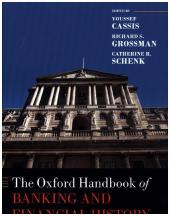 Neuerscheinungen 2016Stand: 2020-02-01 |
Schnellsuche
ISBN/Stichwort/Autor
|
Herderstraße 10
10625 Berlin
Tel.: 030 315 714 16
Fax 030 315 714 14
info@buchspektrum.de |

Youssef Cassis, Richard S. Grossman, Catherine R. Schenk
(Beteiligte)
The Oxford Handbook of Banking and Financial History
Herausgegeben von Cassis, Youssef; Grossman, Richard S.; Schenk, Catherine R.
2016. 556 S. 250 mm
Verlag/Jahr: OXFORD UNIVERSITY PRESS; OUP OXFORD 2016
ISBN: 0-19-965862-5 (0199658625)
Neue ISBN: 978-0-19-965862-6 (9780199658626)
Preis und Lieferzeit: Bitte klicken
The financial crisis of 2008 aroused widespread interest in banking and financial history. Contributions to this volume analyse banking and financial history in a long-term comparative perspective. Lessons drawn from these analyses may well help future generations of policy makers avoid a repeat of the financial turbulence that erupted in 2008.
The financial crisis of 2008 aroused widespread interest in banking and financial history among policy makers, academics, journalists, and even bankers, in addition to the wider public. References in the press to the term ´Great Depression´ spiked after the failure of Lehman Brothers in November 2008, with similar surges in references to ´economic history´ at various times during the financial turbulence.
In an attempt to better understand the magnitude of the shock, there was a demand for historical parallels. How severe was the financial crash? Was it, in fact, the most severe financial crisis since the Great Depression? Were its causes unique or part of a well-known historical pattern? And have financial crises always led to severe depressions?
Historical reflection on the recent financial crises and the long-term development of the financial system go hand in hand. This volume provides the material for such a reflection by presenting the state of the art in banking and financial history. Nineteen highly regarded experts present chapters on the economic and financial side of banking and financial activities, primarily though not solely in advanced economies, in a long-term comparative perspective. In addition to paying attention to
general issues, not least those related to theoretical and methodological aspects of the discipline, the volume approaches the banking and financial world from four distinct but interrelated angles: financial institutions, financial markets, financial regulation, and financial crises.
The book is a good one, indeed financial economists and graduate students in particular will be well served to read it. I feel a lot of finance research today is conducted in the absence of historical context, and so this book is a good start to filling that void, especially since (as far as I am aware) there is no equivalent alternative out there. Phong T. H. Ngo (Australian National University), Economic Record


